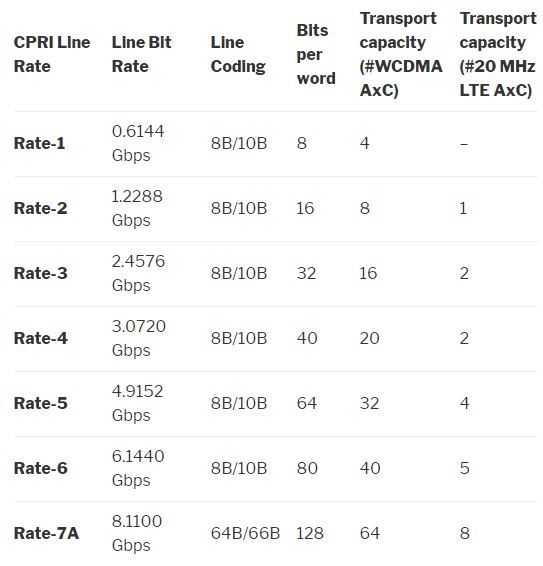We used to post What is CPRI (Common Public Radio Interface)? article ready. This post introduce to CPRI Interfaces for 5G Base Stations.
The Common Public Radio Interface (CPRI) standard defines the interface of 5G base stations between the Radio Equipment Controllers (REC) in the standard, to local or remote radio units, known as Radio Equipment (RE) or Remote Radio Heads (RRH).
For Cellular 3G/4G/LTE/5G operators, “Front Haul” links using CPRI are offered which allows remote positioning of the base station antennas, enhancing coverage and increasing flexibility of network deployment.
A remote radio head is a remote radio transceiver that connects to an operator radio control panel via electrical or wireless interface.
In wireless system technologies such as GSM, CDMA, UMTS, LTE this Radio equipment is remote to the BTS/NodeB/eNodeB, and is also called Remote Radio Head. These equipment will be used to extend the coverage of a BTS/NodeB/eNodeB like rural areas or tunnels. They are generally connected to the BTS/NodeB/eNodeB via a fiber optic cable using Common Public Radio Interface protocols.
Remote radio heads (RRHs) have become one of the most important subsystems of today’s new distributed base stations. The remote radio head contains the base station’s RF circuitry plus analog-to-digital/digital-to-analog converters and up/down converters. RRHs also have operation and management processing capabilities and a standardized optical interface to connect to the rest of the base station. This will be increasingly true as LTE and 5G are deployed. Remote radio heads make MIMO operation easier; they increase a base station’s efficiency and facilitate easier physical location for gap coverage problems.
The CPRI standard allows for different bit rates. These are easy to achieve over fibre optics with today’s technology. However over wireless links, the capacity is more limited due to available spectrum, link margins, atmospherics and technology limits. The following are defined for CPRI:
CPRI transports I/Q data of particular antenna and particular carrier. This “unit” is called an AxC unit or Antenna-Carrier unit.
Example:
In LTE system, if I=16 bits and Q=16 bits
then one AxC is of length 32 bits.
CableFree has pioneered Front-haul of CPRI over wireless links. Wireless Point to Point links are faster to deploy than fibre optics, and lower latency. Today’s MMW links offer up to 4x10Gbps which can carry 4 complete 10Gbps data streams in parallel to a given site.
Note that generally bit rate options 1,2,3 are available over MMW, and 1,2 over FSO today. These can be “aggregated” using 2+0 and higher (4+0, etc) links to provide higher capacities, for example where more LTE sectors are required.
Continuing Advances in MMW and FSO transmission will enable transport of higher CPRI line rates up to 10Gbps and higher for example
What is CPRI?
The Common Public Radio Interface (CPRI) standard defines the interface of 5G base stations between the Radio Equipment Controllers (REC) in the standard, to local or remote radio units, known as Radio Equipment (RE) or Remote Radio Heads (RRH).
CPRI Line Rates & Applications
For Cellular 3G/4G/LTE/5G operators, “Front Haul” links using CPRI are offered which allows remote positioning of the base station antennas, enhancing coverage and increasing flexibility of network deployment.
Connecting Remote Radio Heads
A remote radio head is a remote radio transceiver that connects to an operator radio control panel via electrical or wireless interface.
In wireless system technologies such as GSM, CDMA, UMTS, LTE this Radio equipment is remote to the BTS/NodeB/eNodeB, and is also called Remote Radio Head. These equipment will be used to extend the coverage of a BTS/NodeB/eNodeB like rural areas or tunnels. They are generally connected to the BTS/NodeB/eNodeB via a fiber optic cable using Common Public Radio Interface protocols.
Remote radio heads (RRHs) have become one of the most important subsystems of today’s new distributed base stations. The remote radio head contains the base station’s RF circuitry plus analog-to-digital/digital-to-analog converters and up/down converters. RRHs also have operation and management processing capabilities and a standardized optical interface to connect to the rest of the base station. This will be increasingly true as LTE and 5G are deployed. Remote radio heads make MIMO operation easier; they increase a base station’s efficiency and facilitate easier physical location for gap coverage problems.
CPRI bit rates Supported
The CPRI standard allows for different bit rates. These are easy to achieve over fibre optics with today’s technology. However over wireless links, the capacity is more limited due to available spectrum, link margins, atmospherics and technology limits. The following are defined for CPRI:
CPRI transports I/Q data of particular antenna and particular carrier. This “unit” is called an AxC unit or Antenna-Carrier unit.
Example:
In LTE system, if I=16 bits and Q=16 bits
then one AxC is of length 32 bits.
CPRI Front-Haul over Wireless
CableFree has pioneered Front-haul of CPRI over wireless links. Wireless Point to Point links are faster to deploy than fibre optics, and lower latency. Today’s MMW links offer up to 4x10Gbps which can carry 4 complete 10Gbps data streams in parallel to a given site.
Continuing Advances in MMW and FSO transmission will enable transport of higher CPRI line rates up to 10Gbps and higher for example






This is Base station for HVAC smart home control field
ReplyDeletePost a Comment